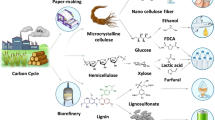Abstract
In this study, pitch crosslinked by oxygen function groups was made into activated carbon (AC) and pore structure was observed. The oxygen functional groups were introduced by the addition of waste PET for pitch synthesis. Activation agent ratios used to obtain the AC during the activation process were 1:1, 1:2 and 1:4 (pitch:KOH, w/w). The oxygen content in the prepared pitch was characterized by elemental analysis. Also, the molecular weight of pitch was investigated by MALDI-TOF. Specific surface area and micropore volume of the prepared AC were determined by the argon adsorption–desorption analysis and calculated using the Brunauer–Emmett–Teller and Horvath–Kawazoe equations, respectively. Micropore fraction of PET-free AC was smaller than that of PET-added AC. At high activation agent ratio, mesopores were created when the micropore structure collapsed. However, in the PET-added AC, due to the oxygen crosslinking effect, the micropore structure and micropore size were maintained even at a high activation agent ratio. Therefore, PET AC was found to have a higher micropore fraction than that of PET-free AC.






Similar content being viewed by others
References
Choudhary R, Kumar A, Murkute K (2018) Properties of waste polyethylene terephthalate (PET) modified asphalt mixes: dependence on PET size, PET content, and mixing process. Period Polytech Civ Eng 68:62
Achilias DS, Karayannidis GP (2004) The chemical recycling of PET in the framework of sustainable development. Water Air Soil Pollut Focus 4:385
Choi YW, Moon DJ, Chung JS, Cho SK (2005) Effects of waste PET bottles aggregate on the properties of concrete. Cem Concr Res 35:776
Foti D (2013) Use of recycled waste pet bottles fibers for the reinforcement of concrete. Compos Struct 96:396
Shukla SR, Harad AM, Jawale LS (2008) Recycling of waste PET into useful textile auxiliaries. Waste Manag 28:51
Kim JG, Kim JH, Song BJ, Jeon YP, Lee CW, Lee YS, Im JS (2016) Characterization of pitch derived from pyrolyzed fuel oil using TLC-FID and MALDI-TOF. Fuel 167:25
Kim JG, Kim JH, Song BJ, Lee CW, Im JS (2016) Synthesis and its characterization of pitch from pyrolyzed fuel oil (PFO). J Ind Eng Chem 36:293
Kim JH, Kim JG, Lee CW, Lee KB, Im JS (2017) Effect of added mesophase pitch during the pitch synthesis reaction of PFO. Carbon Lett 23:48
Albano C, Camacho N, Henàndez M, Matheus A, Gutièrrez A (2009) Influence of content and particle size of waste pet bottles on concrete behavior at different w/c ratios. Waste Manag 29:2707
Chiu SJ, Cheng WH (1999) Thermal degradation and catalytic cracking of poly(ethylene terephthalate). Polym Degrad Stab 63:407
Holland BJ, Hay JN (2002) The thermal degradation of PET and analogous polyesters measured by thermal analysis—Fourier transform infrared spectroscopy. Polymer 43:1835
Yamahuchi C, Mondori J, Matsumoto A, Honma H, Kumagai H, Sanada Y (1995) Air-blowing reactions of pitch: I. Oxidation of aromatic hydrocarbons. Carbon 33:193
Ahmadpour A (1996) The preparation of active carbons from coal by chemical and physical activation. Carbon 34:471
Ahmadpour A (1997) The preparation of activated carbon from macadamia nutshell by chemical activation. Carbon 35:1723
Teng H, Wang SC (2000) Preparation of porous carbons from phenol–formaldehyde resins with chemical and physical activation. Carbon 38:817
Macià-Agullò JA, Moore BC, Amoròs C (2004) Activation of coal tar pitch carbon fibres: physical activation vs. chemical activation. Carbon 42:1367
Qiao W, Ling L, Zha Q, Liu L (1997) Preparation of a pitch-based activated carbon with a high specific surface area. J Mater Sci 32:4447
Koyuncu F, Guzel F, Saygili H (2018) Role of optimization parameters in the production of nanoporous carbon from mandarin shells by microwave-assisted chemical activation and utilization as dye adsorbent. Adv Powder Technol 29:2108
El-Hendawy AA (2009) An insight into the KOH activation mechanism through the production of microporous activated carbon for the removal of Pb2+ cations. Appl Surf Sci 255:3723
Lillo-Ròdenas MA, Cazorla-Amoròs D, Linares-Solano A (2003) Understanding chemical reactions between carbons and NaOH and KOH: an insight into the chemical activation mechanism. Carbon 41:267
Katada N, Kawaguchi Y, Takeda K, Matsuoka T, Uozumi N, Kanai K, Fujiwara S, Kinugasa K, Nakamura K, Suganuma S, Nanjo M (2017) Dealkylation of alkyl polycyclic aromatic hydrocarbon over silica monolayer solid acid catalyst. Appl Catal A 530:93
Torregrosa-Rodrìguez P, Martìnez-Escandell M, Rodrìguez-Reinoso F, Marsh H, Gòmez Salaza C, Romero Palazòn E (2000) Pyrolysis of petroleum residues II. Chemistry of pyrolysis. Carbon 38:535
Mochida I, Korai Y, Ku CH, Watanabe F, Sakai Y (2000) Chemistry of synthesis, structure, preparation and application of aromatic-derived mesophase pitch. Carbon 38:205
Acknowledgements
This work was supported by the Korea Institute of Energy Technology Evaluation and Planning (KETEP) and the Ministry of Trade, Industry & Energy (MOTIE) of the Republic of Korea (No. 20181110200070).
Author information
Authors and Affiliations
Corresponding author
Rights and permissions
About this article
Cite this article
Seo, S.W., Choi, Y.J., Kim, J.H. et al. Micropore-structured activated carbon prepared by waste PET/petroleum-based pitch. Carbon Lett. 29, 385–392 (2019). https://doi.org/10.1007/s42823-019-00028-w
Received:
Accepted:
Published:
Issue Date:
DOI: https://doi.org/10.1007/s42823-019-00028-w




